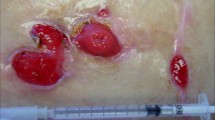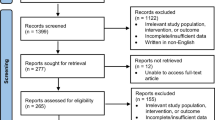Abstract
Background
Pyoderma gangrenosum is a serious cutaneous complication seen in approximately 1 % of patients with inflammatory bowel disease (IBD). Oral corticosteroids are the mainstay treatment, although the evidence supporting their use is weak.
Aims
The purpose of this study was to investigate the characteristics of pyoderma gangrenosum associated with Crohn’s disease or ulcerative colitis and which treatments are prescribed in Spanish clinical practice.
Methods
In this retrospective, observational study, the medical records from all patients with IBD and a diagnosis of pyoderma gangrenosum attended by the gastroenterology departments of 12 Spanish hospitals were reviewed. Data on patient demographics and characteristics, underlying IBD and treatment, and pyoderma gangrenosum characteristics, treatment, and outcome were collected and analyzed.
Results
The data from 67 patients were analyzed (41 [61.2 %] women, 41 [61.2 %] with Crohn’s disease, 25 [37.3 %] with ulcerative colitis, and 1 [1.5 %] with indeterminate disease). The underlying disease was in remission in approximately one-third of patients at the time of presentation of pyoderma gangrenosum. Healing was achieved in all patients (in 3 without any systemic therapy). Oral corticosteroids were taken by 51 patients (76.1 %), almost always as first-line treatment, although definitive healing was attained in 19 (28.4 %). Biologic agents such as infliximab and adalimumab were taken by 31 patients (46.3 %) at some point (first-line in 6 patients [9.0 %]), with definitive healing in 29 patients (93.5 %).
Conclusions
Oral corticosteroid therapy remains the most common treatment for pyoderma gangrenosum associated with inflammatory bowel disease. Biologic therapies such as infliximab and adalimumab should also be considered.
Similar content being viewed by others
References
Ruocco E, Sangiuliano S, Gravina AG, Miranda A, et al. Pyoderma gangrenosum: an updated review. J Eur Acad Dermatol Venereol. 2009;23:1008–1017.
Callen JP, Jackson JM. Pyoderma gangrenosum: an update. Rheum Dis Clin North Am 2007;33:787–802.
Freeman HJ. Erythema nodosum and pyoderma gangrenosum in 50 patients with Crohn’s disease. Can J Gastroenterol. 2005;19:603–606.
Bernstein CN, Blanchard JF, Rawsthorne P, Yu N. The prevalence of extraintestinal diseases in inflammatory bowel disease: a population-based study. Am J Gastroenterol. 2001;96:1116–1122.
Menachem Y, Gotsman I. Clinical manifestations of pyoderma gangrenosum associated with inflammatory bowel disease. Isr Med Assoc J. 2004;6:88–90.
Levine JS, Burakoff R. Extraintestinal manifestations of inflammatory bowel disease. Gastroenterol Hepatol (N Y). 2011;7:235–241.
Callen JP. Pyoderma gangrenosum. Lancet. 1998;351:581–585.
Brooklyn T, Dunnill G, Probert C. Diagnosis and treatment of pyoderma gangrenosum. BMJ. 2006;333:181–184.
Matis WL, Ellis CN, Griffiths CE, Lazarus GS. Treatment of pyoderma gangrenosum with cyclosporine. Arch Dermatol. 1992;128:1060–1064.
Brooklyn TN, Dunnill MGS, Shetty A, et al. Infliximab for the treatment of pyoderma gangrenosum: a randomised, double blind, placebo controlled trial. Gut. 2006;55:505–509.
Heffernan MP, Anadkat MJ, Smith DI. Adalimumab treatment for pyoderma gangrenosum. Arch Dermatol. 2007;143:306–308.
Andrisani G, Guidi L, Papa A, et al. A case of pyoderma gangrenosum with ulcerative colitis treated with combined approach: infliximab and surgery. J Crohns Colitis. 2013;7:421–426.
Van Assche G, Dignass A, Reinisch W, et al. The second European evidence-based consensus on the diagnosis and management of Crohn’s disease: special situations. J Crohns Colitis. 2010;4:63–101.
Best WR, Becktel JM, Singleton JW, Kern F Jr. Development of a Crohn’s disease activity index. National Cooperative Crohn’s Disease Study. Gastroenterology. 1976;70:439–444.
Truelove SC, Witts LJ. Cortisone in ulcerative colitis; final report on a therapeutic trial. Br Med J. 1955;2:1041–1048.
Reichrath J, Bens G, Bonowitz A, Tilgen W. Treatment recommendations for pyoderma gangrenosum: an evidence-based review of the literature based on more than 350 patients. J Am Acad Dermatol. 2005;53:273–283.
Miller J, Yentzer BA, Clark A, Jorizzo JL, Feldman SR. Pyoderma gangrenosum: a review and update on new therapies. J Am Acad Dermatol. 2010;62:646–654.
Poritz LS, Lebo MA, Bobb AD, et al. Management of peristomal pyoderma gangrenosum. J Am Coll Surg. 2008;206:311–315.
Friedman S, Marion JF, Scherl E, Rubin PH, Present DH. Intravenous cyclosporine in refractory pyoderma gangrenosum complicating inflammatory bowel disease. Inflamm Bowel Dis. 2001;7:1–7.
Regueiro M, Valentine J, Plevy S, Fleisher MR, Lichtenstein GR. Infliximab for treatment of pyoderma gangrenosum associated with inflammatory bowel disease. Am J Gastroenterol. 2003;98:1821–1826.
Löfberg R, Louis EV, Reinisch W, Robinson AM, et al. Adalimumab produces clinical remission and reduces extraintestinal manifestations in Crohn’s disease: results from CARE. Inflamm Bowel Dis. 2012;18:1–9.
Zold E, Nagy A, Devenyi K, Zeher M, Barta Z. Successful use of adalimumab for treating fistulizing Crohn’s disease with pyoderma gangrenosum: two birds with one stone. World J Gastroenterol. 2009;15:2293–2295.
Sandborn WJ, Rutgeerts P, Enns R, Hanauer SB. Adalimumab induction therapy for Crohn disease previously treated with infliximab: a randomized trial. Ann Intern Med. 2007;146:829–838.
Rutgeerts P, Sandborn WJ, Feagan BG, Reinisch W. Infliximab for induction and maintenance therapy for ulcerative colitis. N Engl J Med. 2005;353:2462–2476.
Reinisch W, Sandborn WJ, Hommes DW, D’Haens G, et al. Adalimumab for induction of clinical remission in moderately to severely active ulcerative colitis: results of a randomised controlled trial. Gut. 2011;60:780–787.
Acknowledgments
The authors wish to thank Dr. Gregory Morley, on behalf of inScience Communications, Springer Healthcare, for medical writing assistance funded by Asociación Dr. Marina Fiol, Spain. Dr. Gregory Morley, on behalf of inScience Communications, Springer Healthcare, provided medical writing assistance funded by Asociación Dr. Marina Fiol, Spain. This study was coordinated by the Young Group of GETECCU.
Conflict of interest
None.
Author information
Authors and Affiliations
Corresponding author
Rights and permissions
About this article
Cite this article
Argüelles-Arias, F., Castro-Laria, L., Lobatón, T. et al. Characteristics and Treatment of Pyoderma Gangrenosum in Inflammatory Bowel Disease. Dig Dis Sci 58, 2949–2954 (2013). https://doi.org/10.1007/s10620-013-2762-2
Received:
Accepted:
Published:
Issue Date:
DOI: https://doi.org/10.1007/s10620-013-2762-2




